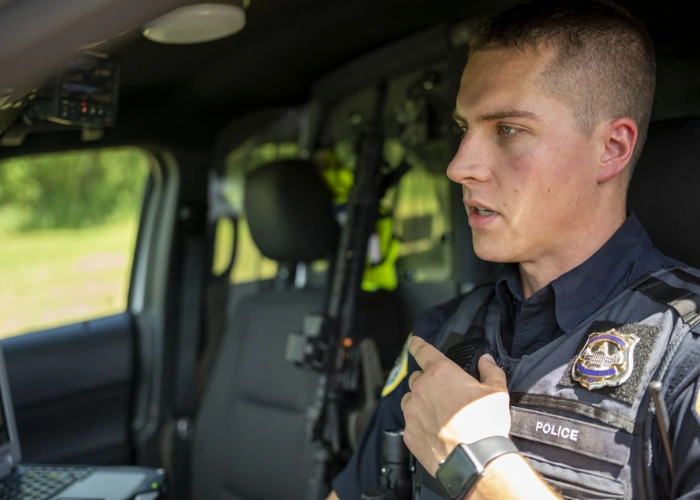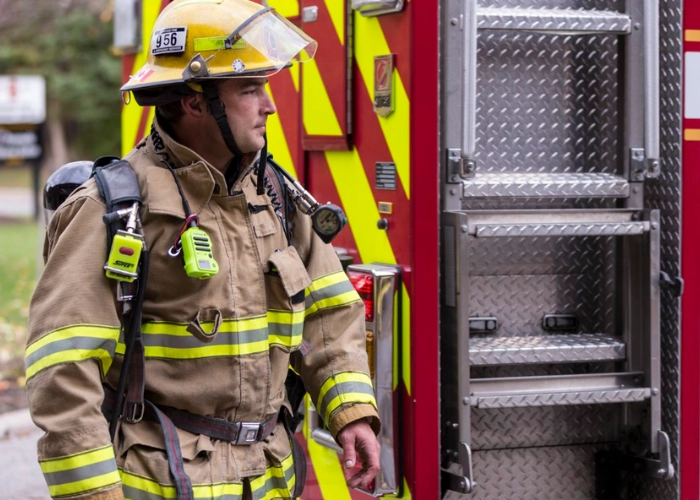Project 25 (P25) is a set of standards for digital radio communications used by public safety agencies. Established to create interoperable and reliable communication systems, P25 allows different agencies to communicate effectively during emergencies. This standard ensures that equipment from various manufacturers can work together, providing critical communication links for law enforcement, fire services, and emergency medical services.
The adoption of P25 has significantly improved coordination and response times in these highly time-sensitive situations, making it a cornerstone of modern public safety communications. In this article, we’ll look further at the history of P25, how the tragic events of September 11, 2001, expedited the adoption of this technology, and the federal grant funding for public radio purchases that must be used for P25-compliant devices.
The History of P25
Project 25 (P25), also known as APCO-25, began in the late 1980s to create a standard for digital two-way radios. Before P25, different agencies had trouble communicating because their radios were incompatible. Public safety professionals in North America, regulatory agencies, and telecommunications leaders developed P25 to solve this problem.
P25 is a suite of standards designed for interoperable digital two-way radio products. It was specifically made for public safety, security, and public service applications. Over time, P25 has gained worldwide acceptance and is also used in commercial settings.
P25 digital radios are designed to replace older analog radios. Unlike the older radios, P25 radios can handle both voice and data. This makes it easier to use features like encryption and text messaging. Dispatch organizations such as police, fire departments, ambulances, and emergency rescue services commonly use P25 radios. These radios are often vehicle-mounted with repeaters and can also be used as handheld walkie-talkies.
By establishing these standards, P25 has enabled different agencies to communicate effectively. As such, agencies can not provide faster response times and coordination during emergencies.
The Impact of 9/11 on P25 Adoption
On September 11, 2001, our country experienced one of the most cataclysmic terrorist attacks in its history. The 9/11 attacks killed 2,977 people and injured thousands more at the World Trade Center in New York City, the Pentagon in Arlington, Virginia, and Somerset County, Pennsylvania. To add to an already devastating situation, these coordinated attacks showed significant issues with emergency response communication systems, which struggled to coordinate efforts due to incompatible radio systems.
The tragic events of 9/11 expedited the adoption of Project 25 (P25) standards for interoperable communication systems. During the chaos of the attacks, many first responders were unable to communicate effectively with each other, leading to delays and confusion that hindered rescue efforts. This showed the critical need for a standardized communication system, allowing different agencies to work together without fail.
In response, the federal government mandated adopting P25 standards for all public safety communications. This mandate was part of a broader effort to improve national security and emergency response capabilities. Federal grants and funding were directed towards ensuring public safety agencies could upgrade their communication systems to be P25-compliant. The urgency to adopt interoperable communication systems became a national priority.
The adoption of P25 has significantly improved coordination during emergencies, providing a more efficient and effective response to incidents. The lessons learned from 9/11 have driven the widespread implementation of P25. And today, this technology is a cornerstone of modern public safety communication systems.

Key Features and Benefits of P25
Project 25 (P25) was designed with specific features to address the communication challenges faced by public safety agencies. These features ensure that different organizations can work together effectively during emergencies. Here are some key benefits of P25:
- Interoperability: P25 ensures that equipment from different manufacturers can work together, allowing seamless communication across various agencies and jurisdictions.
- Reliability: P25 radios consistently perform in urban, rural, and remote environments, ensuring clear communication even in challenging conditions.
- Security: P25 includes advanced encryption standards, protecting sensitive information and ensuring secure communications for law enforcement and other public safety personnel.
- Data and Voice Capability: P25 radios support both voice and data transmission, enabling the use of text messaging, GPS, and other data services alongside traditional voice communication.
- Wide Coverage: P25 systems offer extensive coverage with fewer towers, making them cost-effective and efficient for wide-area communication needs.
- Compatibility with Legacy Systems: P25 radios can operate in both digital and analog modes, ensuring compatibility with older radio systems and facilitating a smooth transition to digital technology.
- Scalability: P25 systems can be scaled to meet the needs of small local agencies or large regional networks, providing flexibility for various operational requirements.
Federal Grant Funding and P25 Compliance
Following the events of 9/11, Congress enacted legislation to improve the interoperability of public safety communication systems. This led to a significant push for adopting P25 standards. Federal grants now support purchasing P25-compliant equipment to ensure uninterrupted and highly reliable communication across different agencies.
Grant applicants must review the P25 standards and include detailed technical requirements in their proposals to demonstrate compliance. They must ensure that all new equipment meets P25 standards and provide documentation from manufacturers to verify compliance. The Department of Homeland Security (DHS) oversees the P25 Compliance Assessment Program (CAP), which tests and certifies equipment to meet P25 standards. This independent testing assures agencies that their equipment performs reliably and interoperates with other P25-compliant systems.
Technical Specifications of P25
Project 25 (P25) standards provide technical specifications distinguishing digital communication from older analog systems. Digital P25 radios offer clearer audio quality and more reliable connections than analog radios. They can also transmit voice and data, which is non-negotiable in today’s public safety operations.
In terms of coverage, P25 systems are designed to work efficiently across wide areas with fewer transmission towers. This makes them cost-effective and practical for both urban and rural environments. P25 radios also use bandwidth more efficiently, allowing more channels to be available within the same frequency spectrum.
Encryption is a key component of P25, with the AES256 encryption standard playing a central role. AES256 provides a high level of security, ensuring that sensitive information remains protected during transmission. This standard is widely endorsed and required for many federal grant-funded communication projects, prioritizing interoperability and secure communication across different agencies.
Implementation and Challenges
Implementing P25 systems presents practical challenges for agencies. One significant challenge is the cost and complexity of upgrading from older analog systems to P25 digital systems. This process requires substantial financial investment and technical expertise to ensure an effective transition free of hiccups.
Interoperability issues can also arise, particularly when different agencies use equipment from various manufacturers that may incorporate features above and beyond the P25 open standard. Agencies should conduct thorough interoperability testing to overcome these challenges and develop detailed project implementation plans. This includes creating acceptance test plans that confirm the new systems can communicate effectively with existing equipment from other vendors.
Another challenge is ensuring secure communication across all devices. P25 addresses this with AES 256-bit encryption, but agencies must manage encryption keys properly and train personnel on secure communication practices.
Coverage and scalability can also pose difficulties, especially in large or rural areas. Agencies should choose scalable solutions that can expand as needed, ensuring adequate coverage and reliability across diverse environments.

Future of P25 and Emerging Technologies
The future of P25 is closely linked to integrating emerging technologies, which continue to evolve its capabilities. For example, Motorola’s APX NEXT radio incorporates advanced features that push the boundaries of public safety communication. Its all-band capability ensures clear and reliable communication across different frequencies, a must for multi-agency operations.
The APX NEXT also leverages smart applications like SmartMessaging, SmartLocate, and SmartMapping to improve situational awareness and operational efficiency. It supports traditional P25 and broadband connections, allowing continuous communication outside of P25 coverage areas via SmartConnect. Additionally, the integration of artificial intelligence, such as the ViQi Virtual Assistant, enables hands-free operation, enhancing the efficiency and safety of first responders.
Improving Public Safety Communications with P25
Clearly, Project 25 (P25) is a must for providing effective communication among public safety agencies. Its standards enable interoperability, allowing different organizations to work together seamlessly during emergencies. This standardization ensures that communication systems are reliable, secure, and capable of supporting voice and data transmission.
The ongoing need for standardized, interoperable communication systems remains non-negotiable as technology advances and emergency responses become more complex. EMCI Wireless can help your organization adopt P25 standards, offering expertise and support for easy, worry-free integration. Contact EMCI Wireless for a free consultation to get started on improving your communication capabilities.

